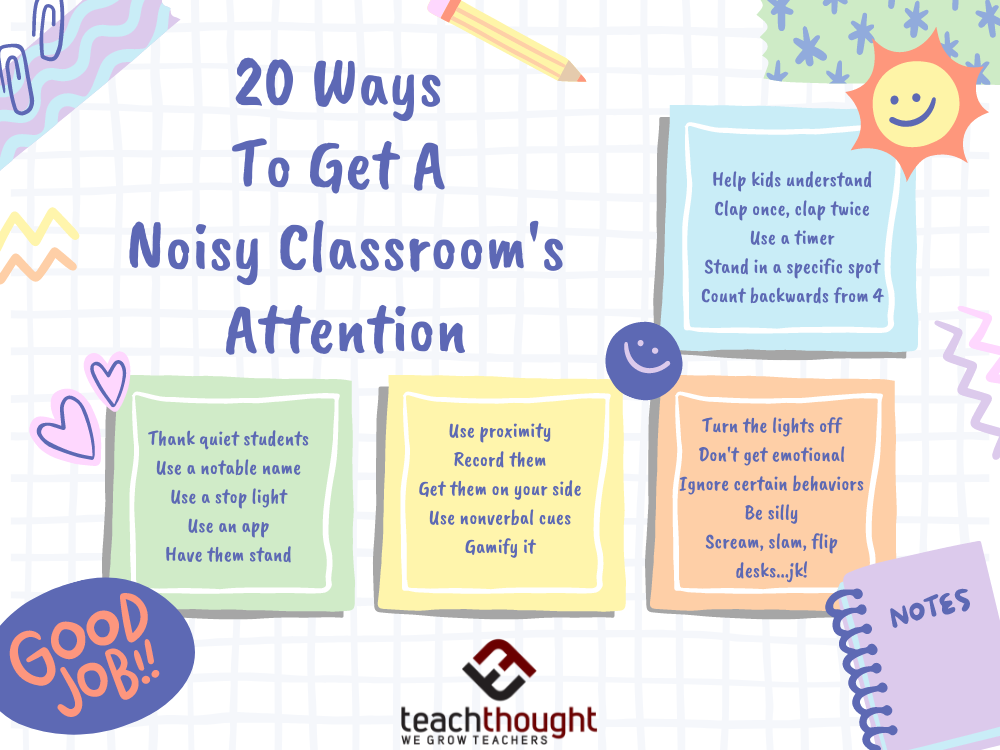
How To Get A Noisy Classroom’s Attention
by Terry Heick
Okay, so this isn’t about rethinking teaching and learning in a connected world, but that doesn’t change the fact that for many of you, simply beginning class can be the most challenging thing you do all day.
It’s not easy. My go-to for years what to simply start teaching, somewhat quietly, and hope students caught on, but I found that stressed some students who were trying to hear and couldn’t, so I had to come up with different strategies.
While muting an entire classroom for 35 minutes at a time so they ‘listen’ isn’t ideal, every teacher needs to quiet a noisy classroom at some point. So recently, when I saw Todd Finley’s post on edutopia offering some fantastic ideas, I had to offer some of the tricks I had learned.
And note, much of what works is indeed about your personality. Classroom management isn’t a ‘strength’ for me because I’m always worried about being a ‘mean teacher’ and tend to use learning models that depend on open-ended learning, student self-direction, and inquiry and project-based learning.
See also 12 Of Our Best Articles About Classroom Management
That said, students deserve to feel protected in a classroom that is efficient, protected, and under the control of a caring adult, so I have to make adjustments to my teaching style and how it relates to my natural personality.
So below are some ways to get a noisy classroom’s attention. Some may work better than others depending on your grade level, teaching style, personality, or the personality of the class itself–down to who shows up to school that day and who doesn’t.
So, on to the list of ways to quiet a classroom.
20 Ways To Get A Noisy Classroom’s Attention
1. Help students understand
No matter the grade level, let students know right away exactly why you need them immediately responsive when you signal for the class to be quiet. Visualize the impact somehow–lost learning, future earnings potential, lowered intelligence each generation, which makes it harder on their great-great-great grandchildren, etc. (That’s obviously sarcastic–don’t use that unless you know what you’re doing.)
Regardless, help them understand that it’s not about authority, it’s about knowledge.
2. Clap once, clap twice
This one is the old standby. After clearly explaining to the students on the first day of school how this will work, stand at the front of the room and say out loud “Clap once if you hear me, clap twice if you hear me,” while modeling the clap.
3. Use a timer
If you’ve got some easy way to instantly project a time for all to see, set it to 3-5 seconds, and let students know the expectation is that each time that the timer reaches zero, the class should be completely silent. You can also tie this to a reward, offering some sort of bonus time once a week or month, and detracting ‘time wasted’ from that bonus time.
4. Stand in a designated spot
And let students know whenever you stand there and raise your hand, a certain finger indicating a requested noise level, etc., that the expectation is that they’re fully quiet within a certain time limit, or even a silent countdown on your fingers.
5. Count backwards from 4
Or count backward out loud from 4, and experiment with slowing your countdown for certain classes to ‘adjust’ to their characteristics, but without giving them too much leeway.
See also How To Give Students Individual Attention In A Busy Classroom
6. Thank students that are already quiet individually
Thanking each student that is quiet, even with bonus items, etc., is a way to positively reward a desired behavior.
7. Use a notable name
Use a key word or phrase that grabs attention–or even have a monthly theme, and whenever students hear a name from that category, they know to be quiet and reward their performance.
8. Use a stoplight
This was from Finley’s list on edutopia, and it’s perfect, Green they can talk, yellow they’re becoming quiet, red they’re silent. eBay, Amazon, etc., all carry products like these. Post it where everyone can see it and use it every day.
9. Use an app
Too Noisy, for example. Experiment and see what works.
10. Have them stand
This one may not work for some classes, but many of my classes that had trouble becoming quiet weren’t being defiant–they were just full of energy. Have them stand and stretch, then begin again.
11. Use proximity
Stand near, or even touch select talking students on the shoulder while beginning to speak. (In some schools, classrooms, grade levels, etc., touching any student for any reason ever isn’t okay–obviously, if this is the case, don’t.)
12. Record them
This wouldn’t work every day, and would only work if you have signed permission from each student’s family and the principal and….but if it fits, start recording, with some visible evidence of doing so. Or even a fake red light that implies recording video. Tell them it’s for a project for a video all parents will see at the end of the year (for elementary), a YouTube channel, documentary, etc.
You know them better than I do–what would convince them?
13. Get the right ones on your side
For more challenging classrooms, especially 8th grade and above, this one is incredibly important. Know who the key ‘players’ are in the classroom, and get them on your side right away. Help them use the leadership skills they have to promote learning in the classroom, and periodically let them know–perhaps away from other students for older kids–how much it helps.
14. Use non-verbal cues
Using non-verbal cues that reflect a behavior system, perhaps one based on positive reinforcement. This can allow you not only to communicate simple messages, i.e., please be quiet, but also more complex messages, such as “The noise level so far has cost us two minutes from our game-based learning lesson on Friday.” How? Use GBL for 15 minutes each Friday, and hold up one additional finger every time students lose a minute.
Through that routine, they’ll get the picture.
15. Gamify it
Gamify your classroom. Give points, take away points, offer badges, let classrooms level up, let them compete against one another, section off groups within a classroom to compete against one another; let their ‘scores’ be rest so those that struggle don’t celebrate being ‘last’ and get worse. This would only work with certain age groups, obviously.
16. Turn the lights off
Who knows why, but most students love the lights off. You don’t have to turn them off and on like a madman–just off, and wait.
17. Resist the temptation to get emotional
Once students sense you’re upset, the implication is that you’re lacking control, and that has a snowball effect. Even if they aren’t, in fact, doing what you want them to, don’t let them in on that secret.
18. Ignore certain misbehaviors
Trying to quiet a noisy classroom is less about discipline and more about routines. If a student makes a joke that gets the class roaring just as they were quieting down, smile a quick smile, let it go, and move on.
19. Be silly
Record audio, Tik Tok videos, or videos on Instagram that aggregate their progress and relative success.
20. Scream at them, slam the door until the glass shatters, flip desks, etc.
Then you’ll get fired and won’t have to worry about it any longer.
20 Ways To Get A Noisy Classroom’s Attention; 20 Ways to Quiet a Noisy Classroom; adapted image attribution flickr user usdepartmentofeducation

